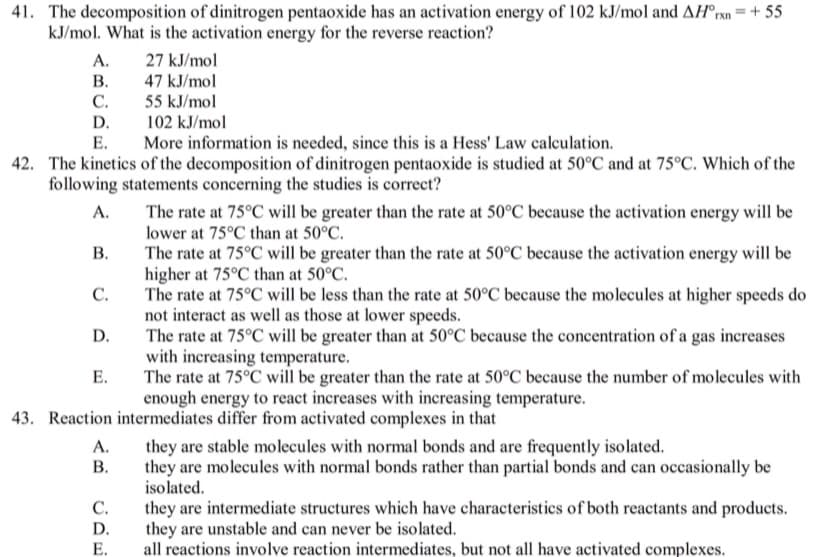The decomposition of dinitrogen pentaoxide has an activation energy of 102 kJ/mol and AH°ran =+ 55 kJ/mol. What is the activation energy for the reverse reaction? 27 kJ/mol 47 kJ/mol 55 kJ/mol A. В. С. D. 102 kJ/mol E. More information is needed, since this is a Hess' Law calculation.
The decomposition of dinitrogen pentaoxide has an activation energy of 102 kJ/mol and AH°ran =+ 55 kJ/mol. What is the activation energy for the reverse reaction? 27 kJ/mol 47 kJ/mol 55 kJ/mol A. В. С. D. 102 kJ/mol E. More information is needed, since this is a Hess' Law calculation.
Chemistry
10th Edition
ISBN:9781305957404
Author:Steven S. Zumdahl, Susan A. Zumdahl, Donald J. DeCoste
Publisher:Steven S. Zumdahl, Susan A. Zumdahl, Donald J. DeCoste
Chapter12: Chemical Kinetics
Section: Chapter Questions
Problem 82E: The decomposition of NH3 to N2 and H2 was studied on two surfaces: Surface Ea (kJ/mol) W 163 Os 197...
Related questions
Question
kindly answer the following question below, choose the best answer. thank u so much

Transcribed Image Text:41. The decomposition of dinitrogen pentaoxide has an activation energy of 102 kJ/mol and AH°rxn=+ 55
kJ/mol. What is the activation energy for the reverse reaction?
A.
В.
С.
27 kJ/mol
47 kJ/mol
55 kJ/mol
102 kJ/mol
More information is needed, since this is a Hess' Law calculation.
D.
Е.
42. The kinetics of the decomposition of dinitrogen pentaoxide is studied at 50°C and at 75°C. Which of the
following statements concerning the studies is correct?
The rate at 75°C will be greater than the rate at 50°C because the activation energy will be
lower at 75°C than at 50°C.
А.
В.
The rate at 75°C will be greater than the rate at 50°C because the activation energy will be
higher at 75°C than at 50°C.
The rate at 75°C will be less than the rate at 50°C because the molecules at higher speeds do
not interact as well as those at lower speeds.
The rate at 75°C will be greater than at 50°C because the concentration of a gas increases
with increasing temperature.
The rate at 75°C will be greater than the rate at 50°C because the number of molecules with
enough energy to react increases with increasing temperature.
С.
D.
Е.
43. Reaction intermediates differ from activated complexes in that
А.
they are stable molecules with normal bonds and are frequently isolated.
В.
they are molecules with normal bonds rather than partial bonds and can occasionally be
isolated.
С.
they are intermediate structures which have characteristics of both reactants and products.
they are unstable and can never be isolated.
all reactions involve reaction intermediates, but not all have activated complexes.
D.
Е.
Expert Solution
This question has been solved!
Explore an expertly crafted, step-by-step solution for a thorough understanding of key concepts.
This is a popular solution!
Trending now
This is a popular solution!
Step by step
Solved in 3 steps

Knowledge Booster
Learn more about
Need a deep-dive on the concept behind this application? Look no further. Learn more about this topic, chemistry and related others by exploring similar questions and additional content below.Recommended textbooks for you

Chemistry
Chemistry
ISBN:
9781305957404
Author:
Steven S. Zumdahl, Susan A. Zumdahl, Donald J. DeCoste
Publisher:
Cengage Learning


Chemistry: An Atoms First Approach
Chemistry
ISBN:
9781305079243
Author:
Steven S. Zumdahl, Susan A. Zumdahl
Publisher:
Cengage Learning

Chemistry
Chemistry
ISBN:
9781305957404
Author:
Steven S. Zumdahl, Susan A. Zumdahl, Donald J. DeCoste
Publisher:
Cengage Learning


Chemistry: An Atoms First Approach
Chemistry
ISBN:
9781305079243
Author:
Steven S. Zumdahl, Susan A. Zumdahl
Publisher:
Cengage Learning

Chemistry for Engineering Students
Chemistry
ISBN:
9781337398909
Author:
Lawrence S. Brown, Tom Holme
Publisher:
Cengage Learning

General Chemistry - Standalone book (MindTap Cour…
Chemistry
ISBN:
9781305580343
Author:
Steven D. Gammon, Ebbing, Darrell Ebbing, Steven D., Darrell; Gammon, Darrell Ebbing; Steven D. Gammon, Darrell D.; Gammon, Ebbing; Steven D. Gammon; Darrell
Publisher:
Cengage Learning

Chemistry & Chemical Reactivity
Chemistry
ISBN:
9781133949640
Author:
John C. Kotz, Paul M. Treichel, John Townsend, David Treichel
Publisher:
Cengage Learning